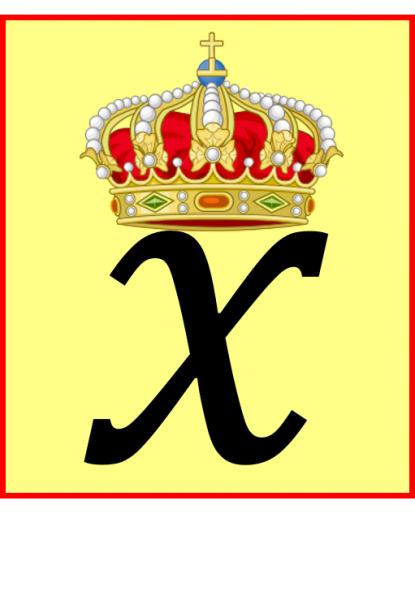a, b, c: lengths of the sides of a triangle, trapezium e.g. Pythagoras $a^2+b^2=c^2$
A, B, C: the three angles in a triangle e.g. sine rule $\frac{a}{\sin(A)}=\frac{b}{\sin(B)}$
a: acceleration
A: Area e.g. area of circle $A=\pi r^2$
b: base e.g. area of triangle $A=\frac{b\times h}{2}$
B: denoting the Binomial distribution in statistics.
c: speed of light $c=3.0×10^{8}$ or prefix for “centi~” meaning $\times 10^{-2}$
C: circumference $C=\pi D$, or Celsius (the unit of temperature), or 100 in Roman Numerals.
d: distance.
D: Diameter of circle e.g. $C=\pi D$, or 500 in Roman Numerals.
e: Euler’s constant $e=2.718281828459045…$
E: Exterior angle of a polygon $E=\frac{360}{n}$ or Energy e.g. $E=mc^2$
f: a function $f(x)$, or no. of faces in Euler’s Polyhedron formula $f+v-e=2$
F: force e.g. Newton’s second law $F=ma$, denoting the F distribution in statistics (named after Fisher).
g: acceleration due to gravity g=9.81 (planet Earth) or g=1.625 (moon).
G: Newton’s Universal Gravitational Constant $G=6.674\times 10^{-11}$ e.g. Newton’s famous inverse square law $F=-\frac{GMm}{r^2}$
h: height.
H: [Help! Must be from School level Maths, not Chemistry or Physics].
i, j, k: unit vectors in the $x, y, z$ directions respectively.
i: used in complex numbers $i=\sqrt{-1}$
I: Impulse in mechanics $I=mv-mu$ or in physics the Moment of Inertia (the “rotational analogue of mass”).
j: alternative symbol for $i$ in complex numbers $j=\sqrt{-1}$
J: Joules (the unit of energy).
k: prefix for “kilo~” meaning $\times 10^3$
K: Kelvin (the S.I. unit of temperature – admittedly more physics than maths?).
l: length.
L: the number 50 in Roman Numerals.
m: mass e.g. $F=ma$ or metres, the unit of length.
M: another (larger) mass e.g. Newton’s inverse square law $F=-\frac{GMm}{r^2}$ or the prefix for “Mega~” meaning $\times 10^6$, or 1000 in Roman Numerals.
n: a unknown counting number e.g. “assume there are n people”, or “find the nth term”.
N: Newtons (the unit of force), or denoting a Normal distribution in statistics.
o, O: best avoided as so easily confused with 0 (zero).
p: sometimes used for momentum in mechanics $p=mv$
P: Pressure or Power, also commonly used as a name for a point in the plane.
q: [help?!]
Q: another point in the plane; electrical charge $Q=It$
r: radius e.g. area of a circle $A=π r^2$
R: electrical resistance $V=IR$
s: displacement in constant acceleration formulae e.g. $s=ut+\frac{1}{2}at^2$; seconds (S.I. unit of time); the sample standard deviation in statistics $s=\sqrt{\frac {\Sigma (x-\bar{x})^2}{n-1}}$.
S: sum e.g sum of n terms of a geometric series $S_{n}=\frac{a(1-r^n)}{1-r}$
t: time, or denoting the t distribution in statistics.
T: Temperature, or an unknown value of t, the time.
u: the initial velocity.
U: denoting the Uniform Distribution in statistics.
v: (final) velocity e.g. Kinetic Energy $E_{k}=\frac{1}{2}mv^2$
V: volume e.g. volume of sphere $V=\frac{4}{3}π r^3$, or 5 in Roman Numerals.
w: width e.g. area of rectangle $A=l× w$
W: Watts (the unit of power), Weight $W=mg$, Work Done $W=Fs$
x: free to stand for a general unknown number!!
X: free to use as a general random variable in statistics, or 10 in Roman Numerals.
y: likewise, free to stand for a second unknown number.
Y: free to use as a second random variable in statistics.
z: free to represent a third unknown number. Typically used for an unknown complex number.
Z: in statistics, a random variable with a standardised Normal distribution.

[mc4wp_form id=”399″]